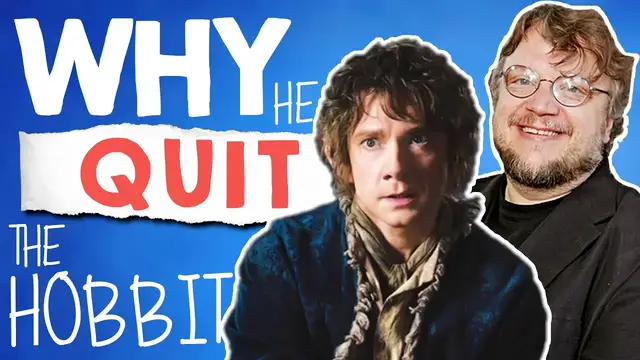When Peter Jackson's Lord of the Rings Trilogy first came out, it was thought to be a perfect adaptation of the famous book written by J.R.R. Tolkien. When talks of going back and adapting the Hobbit, it seemed director Guillermo Del Toro was a perfect match to bring Middle Earth back to life. But as things turn out, Del Toro would soon leave the project after months of work, and Peter Jackson would step back into the directors chair for the Hobbit Trilogy we know today.
Show More Show Less View Video Transcript
0:00
I was hanging by a thread of my arm for so long that at the end of the day, you had to cut it off
0:06
Iconic director Guillermo del Toro's struggle to get The Hobbit made is the stuff of legends at this point
0:13
Never has there been a more perfect match of filmmaker and source material, and yet it wasn't enough
0:18
From studio bankruptcies and behind-the-scenes frictions to the lawsuits around realities of business
0:25
Tragically, The Hobbit, directed by Guillermo del Toro, was just never meant to be
0:30
The Lord of the Rings, directed by Peter Jackson, is looked at by many as the greatest trilogy in the Western film canon
0:36
Produced by New Line Cinema and almost four years of prep time prior to cameras rolling
0:41
each film was constructed with care, attention to detail, and loving reverence to the novels they were adapted from
0:47
With the trilogy's legacy gaining momentum every day, it was only natural that the Hollywood players would be working behind the scenes
0:54
to recreate this success, to engineer a second trip into Middle Earth
0:59
Only problem was that it was going to be a very bumpy ride. I'm going on an adventure
1:04
The Hobbit had actually been Jackson's first goal for adaptation. As early as 1995, Jackson and co-writer Fran Walsh
1:11
had envisioned a trilogy that would include The Hobbit as the first film
1:15
and the second two films being Lord of the Rings, Part 1 and 2. This version of the franchise caused the rights of The Hobbit and The Lord of the Rings
1:22
to become muddied and bound in different production entities. At one point, Miramax ended up with The Lord of the Rings rights
1:28
and producer Saul Zantz, backed by MGM and United Artists, ended up with The Hobbit
1:33
When New Line eventually ended up producing the trilogy, they could only adapt Fellowship, Two Towers, and Return
1:40
and had to remove The Hobbit from their plans entirely. So after the release of The Ring films
1:44
The Hobbit would be the next logical step. Only problem being that MGM, not New Line
1:49
had the rights until the far distant year of 2010, seven whole years after the global smash success
1:55
of the trilogy sweeping the Oscars. This and the fact that in March of 2005
2:00
Jackson launched a lawsuit against New Line. He claimed they had not paid him residuals
2:04
for the revenue generated by merchandising, video games, and home video sales
2:09
Understandably this muddied the water if Jackson would be involved in any more productions centered around Middle Earth But it did leave us with the issue of okay so what now
2:19
In December of 2007, after a fractious back and forth between Jackson and New Line, a joint press release was issued
2:26
Jackson would return to the fold and produce The Hobbit and an untitled sequel
2:30
which would be co-financed and co-produced by New Line and MGM. However, just a few short months later, in February of 2008, things started to get rocky
2:38
on two fronts. The Tolkien estate sued HarperCollins, the publisher of The Rings books, and New Line
2:44
Cinema for breaching a contract for lack of proper residuals, as well as a merger between
2:49
Warner Brothers and New Line, which would add a third major studio to the mix of companies
2:53
involved in the production of The Hobbit. It was amidst the backdrop of lawsuits, high-stakes fan interests, and corporate mergers that Guillermo
3:01
Del Toro was hired onto the project. Guillermo del Toro was one of our favorite filmmakers, and in our mind, he was a director that would do a really interesting version of The Hobbit
3:10
Pre-production for The Hobbit began in August with del Toro working with almost all of the creative crew that built the Rings movies
3:17
From production designer to prop makers, almost everyone was getting back into the saddle
3:22
especially the core creative brain trust that wrote the highly acclaimed scripts for the films, Jackson, Walsh, and Philippa Boyens
3:29
They all agreed to work with del Toro to craft his vision of what The Hobbit would be
3:34
During the research process for the films, del Toro developed a take that would be honorific to the book
3:39
but also expand on it in quintessentially del Toro ways. Del Toro viewed Tolkien as being influenced by his time in the trenches
3:46
during World War I when writing The Hobbit. Del Toro wanted to mind that energy and aesthetic were the first film in his duology
3:53
He devised a plan that would have the first of the two films be a darker, more whimsical affair
3:57
something fueled by del Toro's own gothic preoccupations and obsessions with monsters and revenge
4:04
The second film, which would follow that back half of the book's story, would be more of a bridge to the style and aesthetic
4:09
that Jackson had established for the original trilogy. By March of 2009, the crew had their working drafts
4:15
and del Toro had moved to New Zealand. He was working with artists and designers to craft his vision
4:21
He had a rigorous schedule of writing with the Creative Brain Trust from 8 a to 3 p And then he would make his way to the Weta Workshop where he would have copious meetings with the designers and craft people who were building the numerous costumes
4:33
and sets required for the epic story. Concept artists John Hout and Alan Lee
4:38
who both worked on the original trilogy, were brought back and tasked with developing the look of the film
4:43
Additionally, comic book artists from Hellboy creator Mike Mignola was brought in to design monsters and gothic castles
4:49
The Guillermo del Toro version of The Hobbit would have seen some familiar faces who ended up in the finished product, but they would have
4:56
appeared drastically different. Chief amongst the alternative versions might be Azog, the albino
5:01
orc, who is a central antagonist in the existing films. In the Del Toro version, he would have not
5:06
been a CGI rendered performance. He would have been a fully practical suit, much like Lurtz in
5:11
The Fellowship of the Ring. Del Toro wanted a keenly physical presence for the film so that
5:16
The large-scale CGI Smaug would be countered by a more personal and tactile threat for Bilbo and
5:22
the dwarves to contend with. Judging from this concept art and costume camera test image we have
5:27
it would have been a very different experience. Smaug as well would have a much different appearance
5:32
with Del Toro repeatedly stating that he wanted him to have a mouth that would move like a human's
5:38
Much of Del Toro's scripts and approach has still not been revealed due to NDAs. However
5:43
things were about to take a turn for the maestro of genre cinema
5:47
We began writing with Guillermo, and that was wonderful. But unfortunately, we had no green light
5:53
MGM, one of the vital partners in the production, was plunging into bankruptcy
5:58
After a string of poor business decisions, the studio's future was hanging in the balance
6:02
Creditors were poised to take over as much as 95% of the company's assets
6:07
under a wide-reaching financial restructuring agreement. The decision from the studio was made to delay production of The Hobbit
6:13
while still remaining committed to eventually producing the film. This wasn't good enough for Del Toro
6:20
He had spent close to two years preparing the twin projects to be shot simultaneously
6:24
and now, with the studio potentially not even going to be a functioning entity
6:28
he was faced with a choice. Walk or try to wait out an indefinite hiatus from a company actively engaged
6:34
in bankruptcy negotiations with the court. Ultimately he chose to cut and run When asked if the production could move forward sans MGM Del Toro said it wasn just MGM These are very complicated movies economically and politically
6:49
It doesn't get harder than that. I mean, it's the hardest decision I've ever taken
6:54
I have incredible heartache. I feel terrible about it. Tragically, a morass of rights issues
7:02
near studio bankruptcy and external lawsuits caused the del Toro version of The Hobbit to evaporate into thin air
7:09
Instead, a mere month and a half after the announcement that del Toro was leaving
7:13
it was reported that Peter Jackson would be returning to the director's chair
7:16
with an eye on turning the two films into another epic trilogy
7:21
In terms of Guillermo's designs, I looked at it and I thought this would be an amazing Guillermo del Toro film
7:27
However, in an equally cruel twist of the knife, the studio, newly rescued from bankruptcy court
7:33
went to the films as quickly as possible. The del Toro scripts were scrapped and rewritten from the ground up
7:39
now with an expanded cast of characters who were not in Tolkien's original novel
7:43
Because Guillermo del Toro had to leave and I sort of jumped in and took over
7:48
we didn't wind the clock back a year and a half and give me a year and a half prep to design the movie I was going to make
7:53
Due to the pressure to get the newly titled The Hobbit, an unexpected journey into theaters by December 6th of 2012
8:00
everything had to be done immediately. As opposed to four years of prep time on the original trilogy
8:05
the new trilogy would be prepared in just three months, all while Jackson was still finishing his animated epic, The Adventures of Ten Ten
8:13
Ultimately, this rush and feverish attempt at delivering the film on a deadline
8:17
can be felt in almost every aspect of the finished product. It's easy to understand why the film feels undercooked
8:24
Jackson has repeatedly said on some days he was just making things up as they needed
8:28
If Jackson had been given more time, the projects could have been great, but they're not
8:33
It's a story we hear over and over again, creativity being hamstrung and boxed in by studio mandates
8:39
and a futile attempt to meet release dates to show growth to shareholders
8:44
The Hobbit films, both versions of them, had a virtual army of people working to make them good
8:49
But ultimately, you can't fight City Hall or the studio system. I do believe the worst is behind us
#Movies
#Animated Films
#Documentary Films



